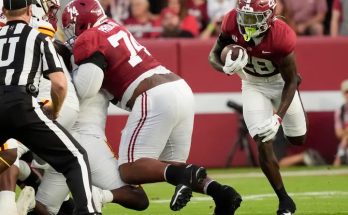Kentucky’s Defense Beats the Scoreboard Despite Giving Up 96 Points
Progress Made, Points Allowed: The Wildcats’ Defensive Metrics Are Increasing!
Winning Big Improvements, Giving Up Big Numbers: Kentucky’s Unlikely Defensive Surge
The Kentucky Wildcats’ latest performance is a paradox in college basketball: their defense is improving, yet they just allowed 96 points. How is that possible? For those who follow the game closely, defense isn’t just about the number of points allowed—it’s about efficiency, execution, and forcing the opposition into difficult situations. Despite giving up a high point total, Kentucky’s defensive statistics suggest progress that bodes well for the future.
The Numbers Behind the Narrative
When scanning a box score, a team surrendering 96 points would typically indicate a poor defensive outing. However, a closer look at Kentucky’s defensive metrics paints a more encouraging picture. The Wildcats have recently shown significant improvements in defensive efficiency, opponent shooting percentage, and forced turnovers, even while engaging in high-scoring affairs.
According to advanced analytics, Kentucky has made strides in defensive rating, a metric that evaluates points allowed per 100 possessions. In their last five games, the Wildcats have improved in this area, despite facing high-powered offenses. Their defensive rotations have tightened, their close-outs on shooters have been more effective, and their ability to contest shots without fouling has been markedly better.
Another key statistic is opponent field goal percentage. While allowing 96 points might seem alarming, Kentucky forced their opponent to shoot well below their season average. This indicates that while their opponent scored a lot, they had to work much harder for their points.
The Pace Factor
One of the biggest reasons for Kentucky’s defensive improvement despite the high point totals is the pace at which they play. The Wildcats have adopted a fast-paced offensive scheme that increases the number of possessions per game. More possessions naturally lead to higher scores for both teams, meaning that raw point totals don’t necessarily reflect poor defense.
Kentucky’s tempo ranks among the highest in college basketball, averaging well above 70 possessions per game. This means that while they might allow more points, they are also generating more scoring opportunities themselves. When adjusted for pace, Kentucky’s defensive rating is significantly better than the raw total suggests.
Defensive Adjustments and Execution
One of the most promising aspects of Kentucky’s recent play has been their ability to force turnovers. Against their last few opponents, the Wildcats have increased their steals and deflections, creating extra possessions and limiting clean looks at the basket. These deflections, even when they don’t result in a direct turnover, disrupt an opponent’s rhythm and often force contested shots late in the shot clock.
The Wildcats have also improved their defensive rebounding, which is crucial in limiting second-chance points. Earlier in the season, Kentucky struggled to box out and control the glass, allowing opponents to score on putbacks. However, recent games have shown a concerted effort to crash the boards, reducing these extra opportunities for their opponents.
Another noticeable improvement is in their on-ball defense. Kentucky’s guards have done a better job pressuring opposing ball handlers, making it difficult to initiate offense cleanly. This has led to longer, more difficult possessions for their opponents, forcing them into tougher shot selections.
The Eye Test: Defensive Intensity and Communication
Beyond the numbers, Kentucky’s defensive intensity has been visibly stronger. Players are closing out on shooters with more urgency, fighting through screens with greater effort, and communicating better on switches. Defensive communication is an underrated aspect of success—being vocal on the court helps prevent breakdowns and ensures that everyone is on the same page.
Coach John Calipari has emphasized accountability on defense, and the players have responded. There’s a noticeable difference in the energy level when defending, particularly in critical moments of the game. Even when opponents are scoring in high numbers, the Wildcats are making them work for every basket rather than giving up easy looks.
Context Matters: The Strength of Opponents
One of the biggest factors in Kentucky’s high points allowed is the quality of the competition they’ve faced. Their recent games have come against some of the best offensive teams in the country—teams that would score high numbers against any defense. Looking at Kentucky’s defensive improvement in the context of their schedule makes their progress even more impressive.
For example, a team averaging 85 points per game scoring 96 against Kentucky isn’t necessarily an indictment of poor defense—it might just be a product of an elite offensive performance. If Kentucky had played against slower-paced, less talented offensive teams, their defensive numbers would look much different.
The Bottom Line: Progress Over Perception
The perception of Kentucky’s defense may be skewed by the raw point totals, but a deeper analysis reveals that the Wildcats are making meaningful strides. Their defensive efficiency, ability to force turnovers, improved rebounding, and intensity all point to a team that is trending in the right direction.
In today’s fast-paced college basketball landscape, evaluating defense purely by points allowed is misleading. Teams play at different speeds, and raw numbers don’t always tell the full story. What matters most is whether a team is getting stops when it matters, forcing tough shots, and creating disruption—and Kentucky is doing all of that better than they were earlier in the season.
As the Wildcats continue to refine their defensive approach, they may still give up high point totals due to their tempo and competition level. However, if they maintain their defensive improvements, they will be a formidable force in the postseason. In the end, it’s not about how many points you allow—it’s about how well you control the game, disrupt the opponent, and ultimately, win. Kentucky’s defense is doing exactly that.



